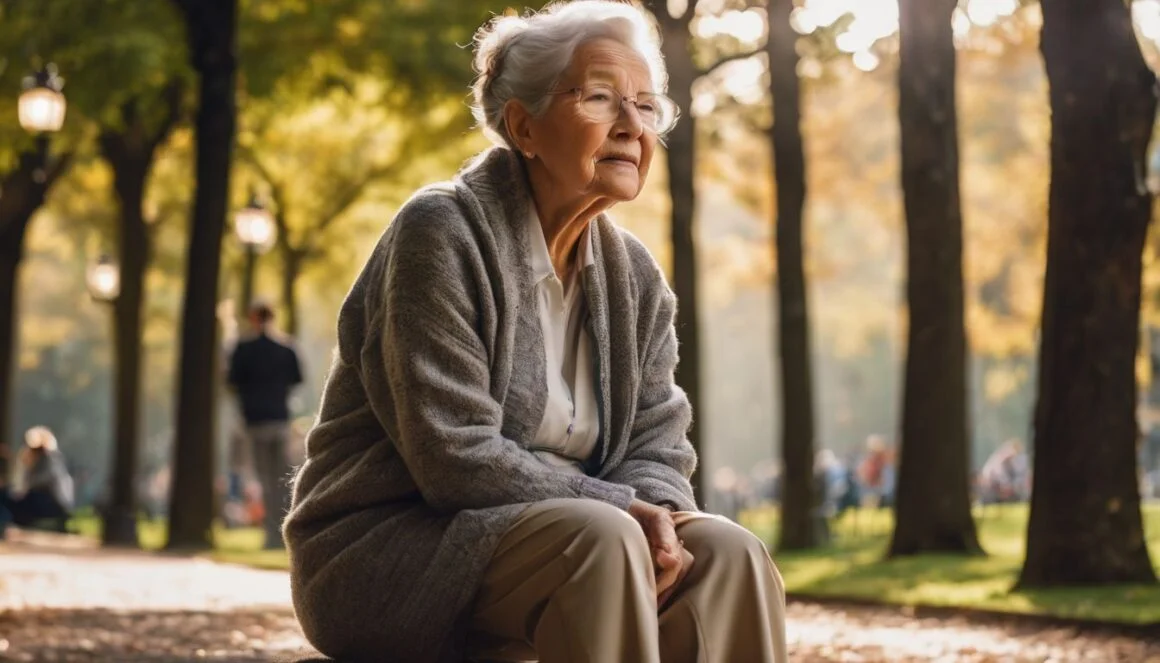Living with chronic pain in your 50s can be an overwhelming challenge. According to the Australian Pain Society, this age group often underreports their discomfort.
This blog will provide you with comprehensive strategies for effectively managing and reducing chronic pain, from traditional medication to alternative therapies.
Stick around to gain control over your pain instead of it controlling you!
Key Takeaways
- Chronic pain in your 50s is not a normal part of aging and can be effectively managed.
- Strategies for managing chronic pain include exercise, physical therapy, medication, and mindfulness techniques like meditation.
- It’s important to communicate with healthcare professionals about your pain and explore different treatment options that suit your individual needs.
- Non-pharmacological alternatives such as bioelectric therapy, psychological treatment (like cognitive-behavioral therapy), and alternative therapies (like acupuncture) can also help alleviate chronic pain.
Managing Chronic Pain in Older Adults

Chronic pain is not a normal part of growing old. It is a lasting problem that can occur at any age. People in their 50s often face this kind of pain. This type of pain does not go away and it lasts for more than three months.
The biopsychosocial model tells us about chronic pain. It says biology, psychology, and social factors all play parts in such pain. For example, back or joint pains are biological problems while stress adds to the hurt as a psychological factor.
This is why chronic pain becomes hard to manage for older people who also have musculoskeletal disorders or other health issues. They may feel constant distress from diseases or injuries adding to their long-term suffering.
Each person’s response to long-lasting discomfort differs depending on elements like emotional factors and personal background.
Pain assessment tools help doctors find out where it hurts and how much it hurts so they can plan better treatment options including medication administration along with non-pharmacological interventions like physical activity which helps boost quality of life by reducing perceived suffering among patients dealing with such consistent agony.
Remember that we need both drug-based treatment along with activities like exercise when managing ongoing discomfort effectively because each approach supports the other leading towards comprehensive relief-enhancing overall well-being amidst persistent torment experienced especially by those hitting their fifth decade alive on earth!
Why is Chronic Pain Often Underreported in People in their 50s?

People in their 50s do not always tell doctors about chronic pain. This can happen for a few reasons. For one, some assume feeling pain is just part of getting older. They may not know they can get help to feel better.
Others worry about taking pills for pain all the time. They might be scared of side effects or becoming too reliant on medicine. Then, there are those who don’t want to bother the doctor with it since they already have other health problems to talk about.
Managing Chronic Pain in Older Adults

Doctors use many tools for Managing Chronic Pain in Older Adults. They often start by talking with the patient. This talk can help find out where and when the pain started. It may also show what makes it worse or better.
The “OPQRST approach” is a common method that doctors use during this talk with patients to gather information about their symptoms and medical history. The acronym stands for:
O – Onset: When did the symptoms start? Was it sudden or gradual?
P – Provocation/Palliation: What makes the symptoms better or worse? Are there any triggers or activities that exacerbate or alleviate the symptoms?
Q – Quality: How would you describe the nature of the symptoms? Is it sharp, dull, burning, tingling, or any other sensation?
R – Radiation: Does the pain or other symptoms spread or move to other areas of the body?
S – Severity: On a scale of 1 to 10, how intense are the symptoms? How does it affect your daily life and activities?
T – Timing: Does the symptoms occur at a particular time of the day? Is it constant or intermittent? How long does it last?
By using this approach, doctors can gather a comprehensive understanding of the patient’s symptoms, which can assist in making an accurate diagnosis and developing an appropriate treatment plan. .
Next, they might test how bad the pain is felt by the person suffering from it. Numeric rating scale (NRS) and verbal descriptor scale (VDS) The numeric rating scale (NRS) is a rating system that uses numbers to measure and quantify a specific characteristic or attribute.
It involves assigning a numerical value to represent the intensity or severity of a particular factor. For example, in pain assessment, patients may be asked to rate their pain on a scale of 0 to 10, with 0 indicating no pain and 10 indicating the worst possible pain.
On the other hand, the verbal descriptor scale (VDS) is a rating system that uses descriptive words or phrases to assess a specific variable. It involves using words or phrases to verbally describe the intensity or severity of a particular aspect.
Continuing with the pain assessment example, patients may be asked to select a word or phrase, such as “no pain,” “mild pain,” “moderate pain,” “severe pain,” or “extreme pain” to indicate their level of discomfort.
Both the NRS and VDS are commonly used in various fields such as healthcare, research, and psychology to assess and measure subjective experiences or perceived attributes. The choice between the two scales depends on the specific context and the type of data that needs to be collected. are two ways commonly used for this purpose.
Methods to Manage Chronic Pain

Exercise, physical therapy, medication, and meditation and mindfulness are effective methods for managing chronic pain.
Exercise
Moving your body is one way to handle chronic pain. Light activities like walking, swimming, yoga, pilates and dancing can help. Even daily hobbies can help make you feel better. Exercise has many benefits for people with chronic pain in their 50s.
It eases pain and makes moving around easier during everyday tasks. Plus, it doesn’t have to be hard or take a long time! All you need to do is find an activity you enjoy and stick with it.
Physical Therapy
Physical therapy is a recommended method for managing chronic pain in people in their 50s. It can help improve physical movement and relieve pain, making daily activities more comfortable.
A tailored treatment plan that includes physical therapy is important for older individuals living with chronic pain. In addition to physical benefits, mindfulness and meditation techniques used during physical therapy aim to change how individuals perceive their pain, enhancing overall well-being and quality of life.
Medication
There are various medications available to help manage chronic pain in people in their 50s. Nonsteroidal anti-inflammatory drugs (NSAIDs) like ibuprofen can be used to relieve pain and reduce inflammation.
Prescription opioids such as hydrocodone and oxycodone may be prescribed for severe pain, but it’s important to use them cautiously due to the risk of addiction and abuse. Other options include antidepressants and antiepileptic drugs, which can help with nerve-related pain.
Additionally, topical treatments like lidocaine patches or creams can provide localized relief. It’s essential to work closely with a healthcare professional when considering medication options, as they can explain potential side effects and ensure that the chosen medication is safe based on individual health conditions or other medications being taken.
Meditation and Mindfulness
Meditation and mindfulness are techniques that can be helpful in managing chronic pain. Meditation involves focusing your attention and eliminating the stream of thoughts that may be causing stress or anxiety.
Mindfulness, on the other hand, is about being fully present in the moment and accepting it without judgment. Research has shown that practicing meditation and mindfulness can reduce pain levels, improve quality of life, and decrease symptoms of depression.
These techniques work by training your brain to become more aware of sensations in your body and helping you develop a different relationship with pain. They can also promote relaxation, lower blood pressure, and increase feelings of well-being.
Pharmacological Management of Chronic Pain
Explore the various options of nonprescription medications, prescription medications, and trigger point injections to effectively manage chronic pain in your 50s.
Nonprescription Medication
Nonprescription medication, also known as over-the-counter medication, can be helpful in managing chronic pain. These are medications that you can buy without a prescription from a doctor.
Some common examples include pain relievers like ibuprofen and naproxen sodium. These medications work by reducing inflammation and blocking pain signals in the body. It’s important to follow the recommended dosage instructions and talk to your doctor or pharmacist if you have any questions or concerns.
While nonprescription medication can provide temporary relief for mild to moderate pain, it’s essential to remember that they may not be suitable for everyone, especially those with certain medical conditions or who take other medications regularly.
So always consult with your healthcare professional before taking any new medication, including nonprescription ones.
[Relevant Fact]: Some dietary supplements, such as fish oils and SAMe (S-adenosyl-L-methionine), show evidence of benefit for chronic pain but further research is required. [Relevant Fact]: Herbal remedies like white willow bark, devil’s claw, cat’s claw, ginger, and turmeric have evidence supporting their use for chronic pain.Prescription Medication
Prescription medication is often used to manage chronic pain. It can help provide relief and improve your quality of life. There are different types of prescription medications that your doctor may prescribe, such as opioids, which can help with severe pain.
However, it’s important to note that opioids have the potential for abuse and dependence. Other options include nonsteroidal anti-inflammatory drugs (NSAIDs), which can reduce inflammation and relieve pain, or antidepressants and anticonvulsants, which can be helpful for treating neuropathic pain.
It’s crucial to work closely with your healthcare provider when taking prescription medication for chronic pain to ensure the right dosage and monitor any side effects or drug interactions that could occur.
Trigger Point Injections
Trigger point injections are a type of treatment used to relieve pain in specific areas of the body. They involve injecting local anesthetic and sometimes corticosteroids into tight knots of muscle called trigger points.
These injections can help with various types of chronic pain, like muscle pain, fibromyalgia, and tension headaches. The effects of these injections can last for weeks or even months, providing long-term relief from pain.
Trigger point injections are considered safe and minimally invasive, making them a good option for managing chronic pain.
Non-Pharmacological Management of Chronic Pain
Non-pharmacological management of chronic pain includes bioelectric therapy, psychological treatment, and alternative therapies.
Bioelectric Therapy
Bioelectric therapy is a non-medication way to manage chronic pain. It works by using electrical signals to stimulate the nerves in our bodies. The aim of bioelectric therapy is to block the pain signals and help release natural pain-relieving chemicals called endorphins.
This type of therapy can be used for different types of chronic pain, such as back pain, osteoarthritis, and fibromyalgia. The good thing about bioelectric therapy is that it is safe and well-tolerated with only minimal side effects.
Psychological Treatment
Psychological treatment is an important approach to managing chronic pain in people in their 50s. It focuses on the emotional and psychological aspects of pain. One common form of psychological treatment is cognitive-behavioral therapy (CBT).
This type of therapy helps individuals identify and change negative thoughts and behaviors that may contribute to their experience of pain. It also teaches coping skills, relaxation techniques, and stress management strategies.
Another psychological treatment option is mindfulness-based stress reduction (MBSR), which involves paying attention to the present moment without judgment. Research shows that these psychological treatments can improve pain symptoms, reduce distress, and enhance quality of life for individuals with chronic pain.
Alternative Therapies
Alternative therapies are additional options that can help manage chronic pain. Some recommended alternative therapies include acupuncture, which involves inserting thin needles into specific points on the body to alleviate pain; chiropractic treatment and massage, which involve manipulating the musculoskeletal system to reduce pain; and therapeutic touch and Reiki healing, which use energy transfer techniques to promote relaxation and relieve pain.
These alternative therapies can be used alongside traditional methods like exercise and medication to provide holistic relief for chronic pain. Additionally, dietary supplements and herbal remedies may also offer potential benefits in managing chronic pain, but more research is needed to fully understand their effectiveness.
Changing one’s diet by reducing intake of unhealthy fats and incorporating anti-inflammatory plant foods may also help ease pain by reducing inflammation in the body.
Mind-Body Therapies
Incorporate mind-body therapies such as acupuncture, chiropractic treatment, massage therapy, and therapeutic touch to alleviate chronic pain.
Acupuncture
Acupuncture is a mind-body therapy that can help manage chronic pain in people in their 50s. It involves the use of thin needles inserted into specific points on the body to stimulate energy flow and promote healing.
Acupuncture has been shown to have positive effects for chronic pain, including back pain, joint pain, and neuropathic pain. It is often combined with other mind-body therapies like meditation and massage for better results.
Importantly, it should be used alongside other treatments like physical therapy and psychological treatment for a comprehensive approach to managing chronic pain. However, before trying acupuncture or any other mind-body therapy, it’s important to inform your doctor as they can interact with medications and impact your health.
Chiropractic Treatment and Massage
Chiropractic treatment and massage are two mind-body therapies that can be effective in managing chronic pain. Chiropractic treatment focuses on the relationship between the spine and nervous system, using spinal adjustments to alleviate pain and improve overall function.
This therapy is often used for musculoskeletal conditions such as back pain and joint pain. On the other hand, massage therapy involves applying pressure to specific areas of the body to reduce muscle tension and promote relaxation.
It can help relieve pain caused by tight muscles or soft tissue injuries. Both chiropractic treatment and massage have been shown to provide relief from chronic pain, improving quality of life for individuals in their 50s.
Therapeutic Touch and Reiki Healing
Therapeutic touch and Reiki healing are two mind-body therapies that can be used to manage chronic pain. These therapies focus on addressing the physical and emotional aspects of pain to promote relaxation, healing, and improved quality of life.
In therapeutic touch, practitioners use their hands to help alleviate pain and promote relaxation. Reiki healing, on the other hand, is a Japanese technique where energy is channeled through the practitioner’s hands to facilitate healing.
By integrating these approaches with medication, individuals with chronic pain can experience relief from their symptoms while also addressing their emotional well-being.
Nutritional Supplements and Dietary Approaches to Treating Pain
Nutritional supplements and dietary approaches can play a role in managing chronic pain. Certain supplements, like omega-3 fatty acids found in fish oil, may have anti-inflammatory properties that could help reduce pain.
Turmeric and ginger are also known for their potential to alleviate inflammation and provide relief from pain. Additionally, maintaining a healthy diet rich in fruits, vegetables, whole grains, and lean proteins is important for overall well-being and can support the body’s natural healing processes.
It’s important to note that while nutritional supplements and dietary changes may have some beneficial effects, they should not replace medical treatment or prescribed medications.
Consulting with a healthcare professional before starting any new supplement or making significant dietary changes is always recommended.
1. The article discusses the use of topical nonsteroidal anti-inflammatory drugs (NSAIDs) in the treatment of osteoarthritis.
2. A systematic review focused on the pharmacokinetics of drugs in cachectic patients.
3. The definition of pain has been updated.
4. The burden of major musculoskeletal conditions is highlighted.
5. Guidelines on the management of pain in older people are mentioned.
Things to Consider when Managing Chronic Pain
- Understand that everyone’s experience with chronic pain is unique and what works for one person may not work for another.
- Be patient with yourself as you explore different methods of pain management, as it may take time to find the right combination that works for you.
- Start small and gradually increase your activity levels or try new treatments, as pushing yourself too hard can potentially worsen your pain.
- Take note of any triggers or activities that seem to aggravate your pain and try to avoid or modify them when possible.
- Keep a journal to track your pain levels, medications, and treatments, which can help you identify patterns or trends over time.
- Communicate openly with your healthcare provider about your pain and any concerns or questions you may have regarding potential treatments or medications.
- Consider seeking support from friends, family, or support groups who can provide encouragement and understanding throughout your pain management journey.
- Be mindful of the impact of stress on your pain levels and practice stress – reduction techniques such as deep breathing exercises or engaging in activities that bring you joy.
- Prioritize self – care by getting enough sleep, eating a balanced diet, and practicing good posture to help alleviate some of the strain on your body.
- Lastly, remember that managing chronic pain is an ongoing process, so be flexible and open – minded as you continue to explore different strategies for finding relief.
Chronic Pain Clinics: An Overview
Chronic pain clinics play a crucial role in managing chronic pain in individuals in their 50s. These specialized clinics provide an overview of the various treatment options available and create tailored plans to address the specific needs of each patient.
They take into account the biopsychosocial model, which recognizes that chronic pain is influenced by biological, psychological, and social factors. By combining both pharmacological and non-pharmacological interventions, these clinics aim to improve the quality of life for patients suffering from chronic pain.
One key aspect of treatment is the use of topical nonsteroidal anti-inflammatory drugs (NSAIDs) for conditions such as osteoarthritis. Guidelines on pain management for older people are essential due to the prevalence of major musculoskeletal conditions in this age group.
In addition, special considerations must be taken into account when managing persistent pain in older individuals at these clinics. Overall, chronic pain clinics offer comprehensive care that addresses both physical and emotional aspects of chronic pain management.
Conclusion
In conclusion, managing chronic pain in your 50s requires a comprehensive approach that takes into account the physical, psychological, and social factors involved. By combining exercise, physical therapy, medication, and mindfulness techniques like meditation, individuals can find relief from pain while improving their overall quality of life.
It is important to work closely with healthcare professionals to develop a personalized treatment plan that meets individual needs and goals. With the right strategies in place, it is possible to effectively manage chronic pain and enjoy a fulfilling life even in your 50s.
Frequently Asked Questions (FAQs)
1. What is chronic pain?
Chronic pain refers to persistent or long-lasting pain that lasts beyond the normal healing period. It may persist for months or even years, and can negatively impact a person’s daily life and function.
2. How is chronic pain managed?
Chronic pain management involves a multifaceted approach that may include various treatments and therapies. These can range from medication and physical therapy to alternative treatments like acupuncture or cognitive-behavioral therapy. The goal is to improve pain levels and enhance overall function.
3. What is pain and function in relation to chronic pain?
Pain and function are closely linked in the context of chronic pain. Pain can significantly impact a person’s ability to perform daily activities, work, or engage in recreational activities. Effective pain management aims to not only reduce pain but also improve overall functional abilities.
4. How can pain relief be achieved?
Pain relief can be achieved through various means, depending on the underlying cause of the pain and individual circumstances. This may involve the use of prescription drugs, such as analgesics or opioids, physical therapy, lifestyle modifications, or a combination of different treatment modalities.
5. What is acute pain?
Acute pain is typically short-lived and serves as a warning sign for injury or illness. It usually goes away once the underlying cause is treated or healed.
6. What are prescription drugs used for in the management of chronic pain?
Prescription drugs are commonly used to manage chronic pain. They can include medications like nonsteroidal anti-inflammatory drugs (NSAIDs), opioids, muscle relaxants, or antidepressants. These drugs aim to alleviate pain and improve the overall quality of life for patients with chronic pain.
7. How is chronic low back pain treated?
Treatment for chronic low back pain can vary depending on the cause and severity of the pain. It may include a combination of physical therapy, exercise, pain medication, heat or cold therapy, and in some cases, surgical interventions.
8. How is chronic pain managed in older patients?
Chronic pain in older adults requires a comprehensive and individualized approach. It may involve a combination of pharmacological interventions, physical therapy, assistive devices, and lifestyle modifications to improve pain management and overall function in this population.
9. What are the common treatments for chronic pain?
There is no one-size-fits-all approach to treating chronic pain. Common treatments may include

